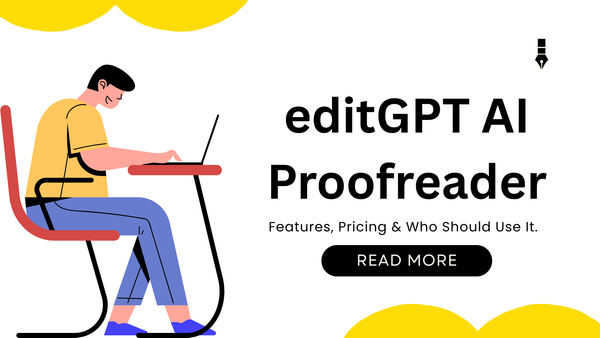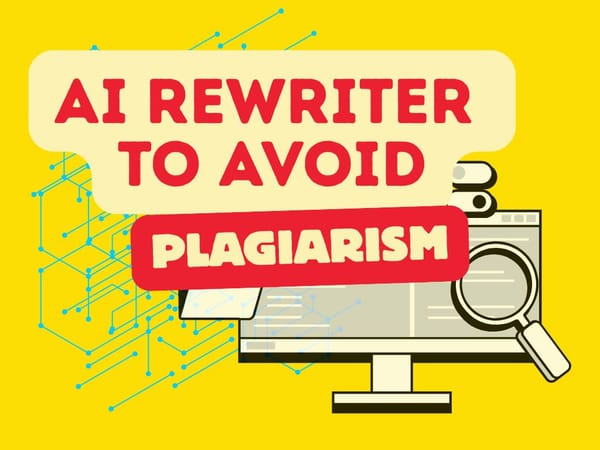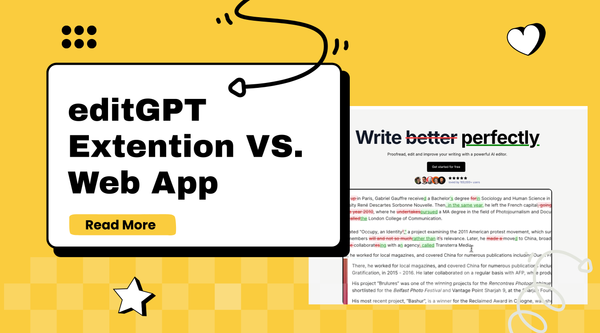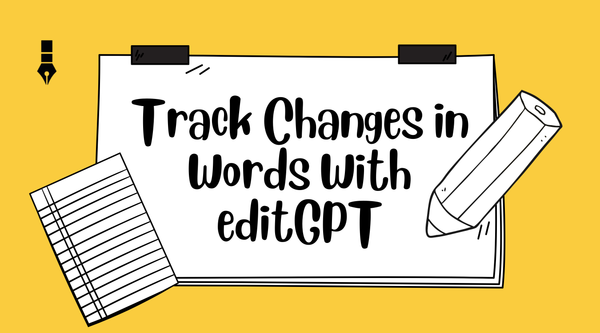We Tested The 7 Best AI Proofreaders in 2025. Here’s What We Found
We tested 7 tools to find the best AI proofreader today. Here's what we found.

We tested these 7 AI proofreaders:
👉 editGPT (Read to see why this is our favorite)
👉 Quillbot
👉 Wordvice
👉 Hemingway App
👉 Wordtune AI
👉 Language Tool
👉 Grammarly
Content errors can cost you your credibility. In fact, 59% of people say that they’d avoid a company with obvious writing errors on its website or marketing materials.
And this is exactly why you shouldn’t rush into choosing just any AI proofreader and hope for the best.
But with so many AI proofreading tools out there, all promising perfect results, it’s easy to feel overwhelmed. So, how do you find the best AI proofreader for your unique needs?
As writers ourselves, we know what it’s like to invest in a tool and hope it delivers. That’s why we’ve done the legwork- to help you make a smart choice and get real value for your money and effort.
Read on to see which AI proofreading tool fits your writing goals best.

1. EditGPT

We’ve seen writers who’ve used the same proofreading tools for years switch to this one, and here’s why:
editGPT is what happens when you combine ChatGPT’s brain with a copy editor’s sharp eye for detail. What stood out the most after just three days of using it was that I no longer had to keep switching between tools while using it.
Tech and education influencer Gurru Tech used and reviewed editGPT, saying:
"It's an ideal AI tool for anyone, whether you're a student, professional, or content creator. With editGPT, refining your content has never been easier. It's such a timesaver."
Don’t want to rely entirely on AI and just need smart proofreading that lets you keep your original tone intact? EditGPT has you covered.
"editGPT pretty much gets the grammar part and the proofreading part right every single time. I have not found any problems that were not like a part of my world and it significantly helped me with the grammar here on this."
...says Nerdy Novelist, who shares practical advice on book marketing and self-publishing, along with insights on using AI tools to support both the creative and business sides of writing."
But if you want more features, like Quillbot-style paraphrasing, or plagiarism checks like Grammarly’s, and even writing assistance like Hemingway App’s, EditGPT can do that too.
Love using ChatGPT?
editGPT’s Chrome extension integrates right into it, so you get both smart suggestions from ChatGPT and real-time proofreading right on the same page.
And if you’re working on Microsoft Word, no problem, because editGPT’s rich text formatting supports bold, italics, and more, so you can maintain your document’s formatting.
Even better? You can import and export Word files with tracked changes, so you can see exactly what’s been edited.
Now, you can have your simple proofreading functions if you want, or you can have more.
Dr. Alana Rister (PhD, University of Nebraska), a Science Grad School coach on YouTube used editGPT and here's what she thinks:
"...even with this up to this point, I would say none of that would be considered AI writing. This is all basically editing it and I love that you can choose to accept or reject individual ones and it marks it up like it would mark up a document instead of if you like threw it in ChatGPT and ask it to edit it, it would go through and just rewrite the whole thing."
editGPT can also rewrite, improve, and make your writing sound more natural. It has custom prompts tailored to what you’re working on, from academic formatting to industry-specific editing, like legal and medical writing.
Now, on to the burning question: Is it ideal for long-form writing and editing?
Absolutely. We work on long-form content every day, so we appreciate how editGPT comes with project management features while also supporting multiple revisions.
And if you’re looking for the best AI proofreader for your business…
…editGPT also offers enterprise-grade solutions with powerful collaboration tools and tailored features for your industry. Whether you’re writing for a technical audience, legal or medical professionals, or even grant reviewers, this tool can adapt to fit your specific needs.
Aside from the already handy industry-specific prompts, we were also able to arrange a demo through their customer support. Their representative patiently walked us through everything as we discussed how they can build a custom solution tailored to our business needs.
We love a customer service that goes above and beyond!
Another plus is that you can choose from over 80 languages, with about 20 business languages.
Plans
editGPT can be used for free, with very capable tools such as proofreading, grammar fixes, rewriting, improved language detection, and more. Just note that the free plan comes with a 10,000-word monthly limit.
If you’re working with heavier content, the Pro Plan is ideal for long-form editing and comes with advanced features such as a suggestions panel, batch editing, and new features being added every week. You’ll also get a higher monthly word count of 300,000.
Their Elite Plan gives you a generous 2,000,000-word limit per month, ideal for teams or high-volume writers.
editGPT’s 30-day risk-free trial lets you get a refund if you’re not satisfied. No questions asked. Now, that’s one for peace of mind.
The verdict
We’ve been using and testing out different writing tools for many years now, and editGPT is the first one that made us say, “I don’t need anything else.” We love the flexibility. It can be used for everything from light proofreading to serious business writing needs.
It meets different levels of writing needs, and it fits a wide range of budgets too (I’d say all the plans are already much cheaper than most tools on the market), which is exactly why it earned our top spot as the best AI proofreader overall.
2. Quillbot

Most of us know Quillbot as that go-to paraphrasing tool, but it has since grown into so much more. It’s now a smart writing assistant with tools such as a grammar checker, AI detector, plagiarism checker, and more.
After using it for months, we found Quillbot to be a great value for money among AI proofreading tools as it’s more affordable than most of its competitors, yet still offers almost the same set of features.
So if you’re looking for a budget-friendly AI proofreader that doesn’t skimp on performance, here’s how Quillbot worked for us and how it stacks up against other writing tools on the market.
Quillbot basically comes packed with all the essential writing tools that an everyday writer needs. Its grammar checker has really improved over the years, now working more like Grammarly by catching and highlighting issues in real-time and then giving you smart suggestions.
And yes, it also works across different web pages. Its Chrome extension let me use it while I was drafting a post on X, writing a long thread on Reddit, and even replying to messages on WhatsApp.
And if you’re wondering, Quillbot Premium also integrates well with Google Docs, making it very convenient to use.
So, how’s the proofreading performance?
We all agreed that Quillbot’s grammar checker is decent and accurate enough to catch most grammatical issues. One thing I appreciate is how it gives helpful explanations for each correction. Talk about turning a mistake into a learning opportunity.
That said, you do need to stay sharp.
Although its grammar checker is mostly accurate, we also noticed that Quillbot can be a bit too eager at times.
In one case, out of the 42 corrections it suggested, 2 of them were actually unnecessary.
So while it’s reliable, I advise you to still carefully scan the whole document and use your own judgement in accepting the suggestions.
If you’re wondering about its multilingual capabilities, Quillbot does support multiple languages and even has a translation tool. However, its language range isn’t as extensive as what EditGPT offers.
Customer support is fairly responsive, though some channels are only available on weekends.
Plans
Quillbot is our pick for best value for money and for good reason.
It’s budget-friendly, and even the free plan gives you access to a reliable grammar checker with a 1,200-word AI detector. So, if you’re a student working on your research papers or essays, this might be the tool for you.
Just take note that word count per request is limited.
How about its premium plan?
Its premium plan is still competitively priced, with more features such as unlimited paraphrasing, seven different writing modes, a 20-page monthly allowance for plagiarism checks, and extensions for Microsoft Word, Google Docs, and Chrome.
What’s the verdict?
If you’re looking for an affordable AI proofreader and editor that can deliver a satisfying performance, Quillbot might just be what you need.
Sure, it’s not perfect. There can be occasional hiccups, but if you’re not expecting a flawless, enterprise-grade proofreading tool, Quillbot is more than capable of handling your proofreading needs.
3. Wordvice

Wordvice is often compared to Quillbot, despite the two tools having slightly different priorities.
At first glance, Wordvice’s user interface may look quite similar to Quillbot’s grammar checker. However, to get straight to the point, Wordvice’s focus is mostly on proofreading, alongside its other tools, such as paraphrasing, AI detection, and summarizing tools, among others.
Wordvice also offers different modes for its paraphrasing and proofreading tools.
Its proofreading features include Light and Standard modes. Light mode focuses on fixing grammar and spelling, while Standard does the same but with the addition of improving vocabulary.
That’s for the free plan.
If you’re looking for just a basic AI proofreader, the free plan should be enough to get you started. But if you decide to upgrade, you’ll unlock two more advanced modes: Intensive and Concise.
These two advanced proofreading modes go beyond grammar checks by improving the overall flow of your writing, condensing longer texts, and enhancing clarity for a more polished and professional result.
One small but great feature that I like is the ability to download the results straight into a Microsoft Word file. It also lets you add titles to your chats, making everything easier to find later on.
Plans
Wordvice has three types of plans. The free plan gives you 500 words per request and a limit of 5,000 words monthly.
On the other hand, its Premium plan gives you up to 1,000,000 words monthly and allows up to 10,000 words per request.
It also unlocks 20 pages of AI plagiarism checking and access to additional modes for both its AI paraphrase and proofreader.
If you’re working with a team, Wordvice offers a Team plan starting at $9.95 per month.
The verdict?
If there’s one thing we learned while using Wordvice (and unconsciously comparing it to Quillbot), it’s that Wordvice is suited for academic and professional writing, while Quillbot leans more towards students, bloggers, and casual writers.
Both offered solid proofreading capabilities, though. Quillbot tends to produce a simpler and more relaxed tone that’s easy on the eyes, whereas Wordvice delivers a more polished result while still sounding natural.
And lastly, while it’s an AI proofreading tool, Wordvice also has an option where you can have a real human editor to further refine your work. We didn’t have the chance to use the feature, but it’s appreciated, nonetheless.
4. Hemingway App

Hemingway App has been in my writing arsenal for years now, and it might be in yours too. If it isn’t yet, let me tell you that Hemingway App will have you using at least one more AI proofreading tool because this wasn’t built with grammar checks in mind.
So why is it on this list, you wonder?
Hemingway App can be a great part of your proofreading and editing process if you don’t mind using more than one writing tool.
It’s because Hemingway App’s main job is to help with the readability of your written content. Where this editing tool doesn’t do grammar and spelling checks, it compensates with an in-depth analysis of the complexity of your writing.
It’ll tell you if your sentences are too complex or if you’re using too many words to describe a concept. It will also show if you’re using passive voice or if there are phrases with simpler alternatives.
My favorite thing about it is that everything is color-coded. Blue highlights show how often you used adverbs, green for passive voice, yellow for hard-to-read sentences, and so on. All you will have to do is find them all and edit them yourself.
What’s the con?
If it lacks anything, I’d say it’d be suggestions. Unlike most AI proofreaders on this list, it doesn’t show alternatives to the corrections it gives the user, so you’ll have to revise them yourself or use a different AI tool for it.
Ease of use? Hemingway App is one of the easiest writing tools out there. You can even use it without logging in. Just paste the written content and you’ll instantly get the corrections without pushing a button!
Plans
Hemingway App doesn’t have paid premium plans. You can enjoy its features for free on their website.
But it does have a desktop app that you can get for $19.99. This app will give you offline access to the editor, direct publishing function to WordPress and Medium, as well as the ability to save your work.
The verdict?
Hemingway App is as simple and as comfortable as it gets. It’s very approachable, and its readability checker is fairly competitive if we compare it to other tools with the same feature. Although very limited in its features, its results are accurate and helpful most of the time.
5. Wordtune AI

Wordtune prides itself on its rewriting capabilities while keeping the writer’s voice and tone intact. It’s, in fact, this AI tool’s bread and butter.
So, is it a good AI proofreading tool?
It has grammar and spell-check features that can be comparable to Grammarly. Although I can’t say it’s as strong, it’s still a considerable competition thanks to some of its unique features.
Because Wordtune’s specialty is rewriting, this feature also works alongside its grammar checks. Using its web editor will show you a side panel with corrections and suggestions for your errors. Again, much like Grammarly.
But what sets it apart is the fact that it has more suggestion options for every correction.
Yes, you read that right.
I can even say that it’s a fun feature. It let me see different perspectives, especially when I’m doing creative writing, as this feature also offered me different versions of the sentence I was trying to correct. Quite cool.
You can also change these suggestions depending on your preferred tone and voice.
I love that I was able to preserve my very own style when I was using this tool.
It also has different modes, much like most AI proofreaders on this list. One of the things I appreciate about its editor is how I can add new words to its dictionary, so brand names or technical terms wouldn’t get flagged.
As for its Chrome extension?
It also works like Grammarly in a way that you can use it whenever you are on the internet. Writing emails? Social media posts? A blog? Wordtune will be there to highlight any writing or phrases that need correction.
On the other hand, there were a few occasions when its grammar and spell-checker weren’t able to get all of my (intentional) errors. This is the reason why I said that its proofreading capability isn’t as strong as Grammarly’s.
Like Quillbot, it’s great for students, casual writers, and bloggers.
Plans
Wordtune has very basic features and tools. Its free plan lets you rewrite ten times, including AI suggestions. It also grants you three AI summarizations but unlimited spell and grammar checks.
On the other hand, its Advanced plan, costing $6.99, gives you more features such as AI prompts and more AI summarizations.
Its Unlimited plan gives you, well, unlimited access to all of Wordtune’s tools.
The verdict?
One noticeable thing about Wordtune is how its free plan is kind of a world’s away different from its unlimited plan, unlike other tools that only have a few features as differences between their plans.
Its free plan is one of the most basic out there, and other functions are also very limited. Despite that, it still did its job of correcting grammatical and spelling errors decently. It’s also one of the most affordable AI proofreading tools on the market today.
6. Language Tool

Multilingual capabilities and integration are Language Tool’s best features.
If we talk about Language Tool’s proofreading capabilities, it’s honestly not very special. It’s great, just like how other AI proofreading tools on this list are great. It will give you what you need and will make your editing tasks a breeze.
But we all agreed to include Language Tool in this list because it has one of the best multilingual capabilities out there.
It’s not as great as EditGPT’s, but its proofreading capability in other languages is better than most. It can work with over 30 languages, correcting grammar and spelling mistakes just like in your typical English AI editor.
On the other side of the coin…
…if you’re using Language Tool’s premium advanced features, proofreading in a couple of languages may yield less accurate results. It also has a few tools that are only accessible in the English language setting.
But if you can get past that, you’ll also be amazed at its diverse integrations. It has extensions for most browsers in existence, in addition to having both desktop and mobile apps.
Aside from that, its email add-ons are also already greater than most, catering not only to Gmail but also Outlook, Apple Mail, and many others.
Its user interface is also very beginner-friendly. It’s actually one of the plainest tools I have ever seen in a good way. It’s not distracting, nor is it intimidating.
As for its proofreading performance, as I said, it’s nearly average. It didn’t give me slip-ups like Wordvice did, but its suggestions are also not outstanding. They’re just good.
And well, sometimes, just being good is enough. Especially if you’re a student or a casual writer who needs just a very basic AI proofreader.
Plans
They have four payment intervals to choose from. You can do monthly starting at $12.45, quarterly, annually, or every two years.
Most tools only offer monthly and annual plans, so having this many options is a big plus for me. Do also know that they often give out discounts, so you might want to watch out if you’re planning on trying Language Tools out.
The verdict?
Language Tools can be very simple and also very complex, depending on the plan you’re using. Its free editor is perfectly clean and distraction-free. It actually let me concentrate on my writing and on making it better and more creative instead of switching between different tabs.
It saved me time and energy and helped me make my writings more genuine, which is very refreshing.
Its proofreading capabilities are reliable and refreshing. I didn’t come across any flaws at all while using its English setting.
But if you love advanced features, its free version might not prove satisfactory to you as it’s very basic. On the other hand, its premium features were fun to explore, especially if you’re working in different languages.
7. Grammarly

Who hasn’t been using Grammarly since forever? It was my first proofreading tool before my writing needs grew, and I ventured to look for other AI editing tools.
Although not the first AI proofreader and editor, many people consider Grammarly as the blueprint.
Aside from its spell and grammar checkers, it can also detect your tone and adjust it depending on your intended audience and purpose. It will also suggest other alternatives if your sentences are too complex and hard to understand.
Grammarly is big on drastic editing.
It even overcorrects sometimes with over-suggestions and false positives, so it’s important to use your own judgment and scan through the corrections and suggestions instead of just accepting everything. ‘
But aside from that, its proofreading capabilities are above average, and its suggestions, whether for mispelled words or whole complex sentences, are mostly accurate and natural-sounding.
Its free features are already fairly good, and that’s one of Grammarly’s strengths. Many of its users are already content with using the free version because it’s that decent.
Its suggestions while I was using it were so creative, while still making sense, that it already felt like I was using a premium plan to me.
But if you write for a living and have greater and heavier needs like me, you’ll probably love its premium features such as AI prompts and a fluent English mode, which, I can say, is very spot on.
Plans
Grammarly’s premium plan is called Grammarly Pro, and it costs $30 if billed monthly and $12 a month if billed annually.
Some might say it’s pricier than other AI proofreading and editing tools on the market today. But do know that this plan comes with very advanced proofreading capabilities, a plagiarism checker, cross-browser capabilities, and tone detection, among others.
If you do not care about very advanced features, though, I’d say these are features that can be used for free in other AI proofreading tools.
The verdict?
What can I say? It’s Grammarly, and save from occasional over-editing, its corrections are accurate most of the time.
I’ve used its Pro version for months, and I can say that as someone who writes for a living, its premium tools proved very useful. But for that price, it turned out that I only needed the plagiarism detector.
So it’s also important to evaluate how much you need all of the features the Pro plan offers to make it worth it, as Grammarly’s pricing is no joke.
How did we choose the best AI proofreaders?
Our team writes for a living, and the three of us from this team took turns using both free and premium versions of over ten AI proofreaders and editors for almost half a year just to narrow the list down.
And this is how we came up with these top picks.
But aside from that…
…we also set clear criteria and metrics so we can rate each AI tool fairly. That also made it easier for us to compare each one. We used the most important aspects and things people usually consider when choosing an AI proofreader to buy.
Here are the metrics, and also the things you should take note of when choosing the right writing tool for yourself.
- Ease of use
More than half of AI proofreading, editing, and writing tool users are either beginners or non-professionals. This is why we value a tool’s ease of use and easy user interface.
Editing and proofreading can already be hard and time-consuming enough.
Nobody needs the further hassle of being lost in an editing app or a website, or worse, buying a tool and not being able to use it to its maximum capabilities because it’s too complex to understand.
2. Editing capabilities
This metric is one, if not the most important, criterion we set because it includes all the features a proofreading tool offers, as well as how well they work and how much they help us in our projects.
You could be one of the people who just want their proofreading tools to be simple and basic. Or you could be like me, who loves a tool that’s jam-packed with interesting features.
An AI tool’s editing capabilities aren’t determined by the number of its functions. It’s how accurate and well it works. You can have just two proofreading functions in your AI proofreader, but if it works well, then you still win.
3. Customization
As writers, preserving the original tone, voice, and message of our writings is very important. This is why customization is one of my top requirements when looking for a new AI tool to use.
AI proofreading tools that have great customization capacities will let you fine-tune the AI tool according to your taste, needs, and style. The more customizable a proofreading tool is, the bigger the chance there is that it won’t hijack the writing’s original style and tone.
4. Features
This applies especially to businesses and enterprises. A casual writer might be content with the simple proofreading features. But if you make a living by writing or editing, the additional features most AI tools come with will always prove to be not only important, but life-saving.
Plagiarism checkers, multilingual features, AI detectors, paraphrasing, and many other features helped make our team’s workflow, making it smoother and save us more valuable time.
5. Customer support
However great an AI tool is, it’s still a tool that can crash and act up anytime. And this is where a great customer support comes in.
I still remember those traumatizing moments when I was rushing a project and my AI tool crashed on me. I felt helpless and no one can help me save for the app company’s support team.
The ideal AI proofreader should have 24x7 customer support who will walk you through everything you need to know and won’t leave you until the issue is fixed.
Wrapping it up…
At the end of the day, every writer has different writing and proofreading needs. Some need a full suite of tools to perfect their written project, while some are comfortable with using just one simple AI proofreading tool that gets the job done.
What made us choose editGPT after months of comparing and evaluating is the fact that it caters to both.
It’s both packed with many useful writing and editing tools while still being simple and easy to use.
It’s like a Swiss knife of proofreading.
It’s sleek and compact on the outside, but more than capable when unveiled.
We hope this guide and our own experiences helped you choose the right AI proofreader to invest your time or money in. Remember, the best tool is one that fits your own unique needs, style, and supports your goals.
Recommended Reading
What is the best AI Proofreader?
Best AI Proofreader Tools of 2025 (Tested for Accuracy, Speed & Tone) -
Video review: This AI Text Editing Tool Is FLAWLESS!
Best AI Proofreader Tools of 2025 (Tested for Accuracy, Speed & Tone) editGPT vs Grammarly vs Quillbot: Which Writing Tool is Best?
The Best AI Proofreaders That Actually Work (Free & Paid)
Review: Wordtune Editor vs editGPT
Review: Grammarly vs editGPT
Review: ProWritingAid vs editGPT
Review: Hemingway Editor vs editGPT



